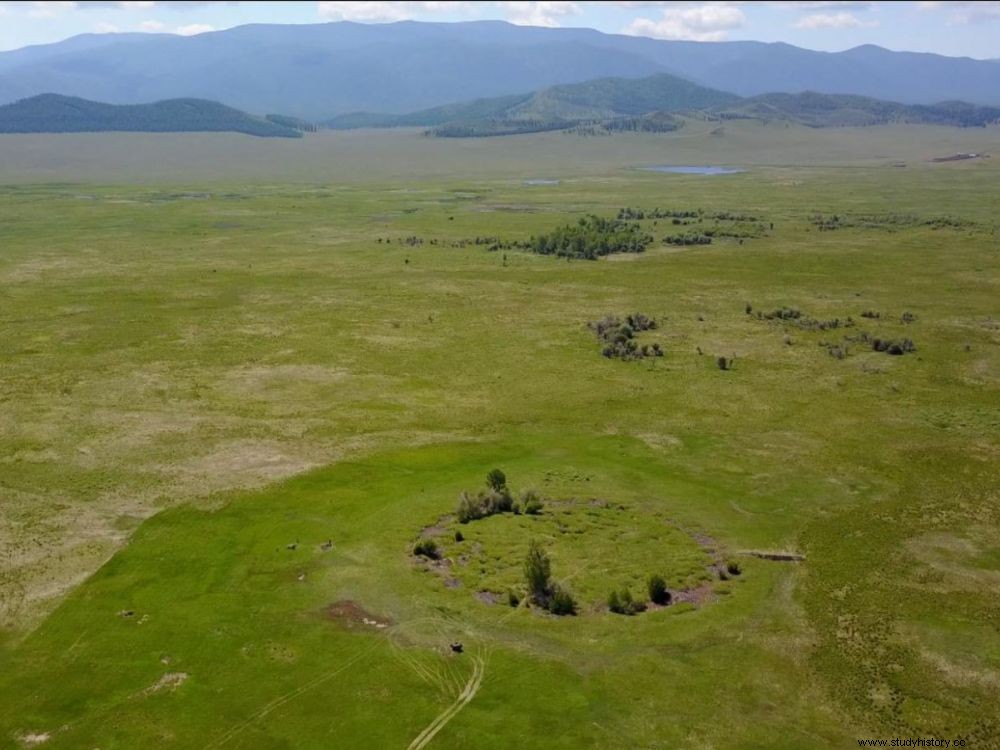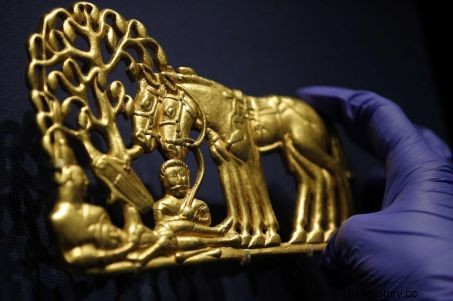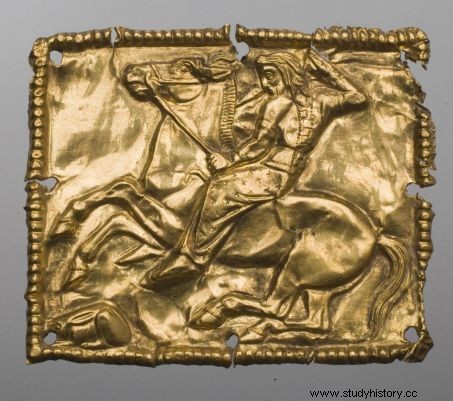Located from satellite images, an imposing, seemingly intact Scythian tomb has been unearthed in southern Siberia.

Aerial view of the tumulus of Tunnug 1, in the republic of Tuva, in southern Siberia.
Archaeologists are feverish. A kurgan inviolate dated 3000 years old and discovered in southern Siberia (Russia) will it deliver new treasures of exceptional richness? These tombs of the Scythian elite, this nomadic people who circulated in the vast steppes of Central Asia as far as southern Russia from the 9 th century before our era, have indeed always made specialists dream. And for good reason ! The excavation of a previous kurgan (Arzhan 2) between 2001 and 2004 delivered the largest set of precious objects ever unearthed in the whole Eurasian plain… In particular quivers, a pectoral of more than 1 kg of solid gold, pins, finely encrusted daggers, embroidered textiles… That is more than 20 kg of precious materials extracted under the control of armed police.
-
 Scythian goldsmith hoard (500 BC). © Franck Augstein/AP/SIPA
Scythian goldsmith hoard (500 BC). © Franck Augstein/AP/SIPA
It is in this same republic of Tuva, thousands of kilometers from Moscow, that the existence of another monumental funerary mound has just been revealed by Gino Caspari, of the Institute of Archaeological Sciences of the University of Bern (Switzerland) who is conducting research on site with Russian archaeologists thanks to funding from the Swiss National Science Foundation (SNSF). For this young researcher, joined by Sciences et Avenir, it has extraordinary characteristics:"The conservation conditions, age, setting and size of this monument make it unique and give it a very high value. scientific. No other frozen kurgan of this magnitude is known in all of Eurasia “, he confides. If the mound of Arzhan 2 is 80m in diameter, this one, named Tunnug 1 by the Russian-Swiss team made 140m.
In a recent publication of the scientific journal Archaeological Research in Asia , the Swiss researcher and his colleagues from the Russian Academy of Sciences and the Hermitage Museum, relate the first field investigations carried out in the summer of 2017 on this site spotted in 2013 in the valley of the Ujuk river, nicknamed the "Valley of the Kings" because of the many remains it contains. The remains of Tunnug 1 , an ancient radial structure made of wooden logs, clearly appeared on the high-resolution satellite images. “This kurgan from a crucial time between the Bronze Age and the Iron Age, where drastic social changes occurred within these nomadic cultures. This is a period about which we do not have much information “, underlines the scientist. Tunnug 1 could thus be not only the largest Scythian tomb in southern Siberia, but the oldest found to date. Radiocarbon dating dates its construction back to the IX th century BC, i.e. one century before Arzhan 1 .
Frozen Corpses Golden Treasures Trailer 2:Siberian Discovery from Trevor Wallace on Vimeo.
However, its geographical location made it inaccessible for several years. "Tunnug 1 is indeed in the middle of a huge swamp “, explains Gino Caspari, three hours by car on very bad roads from the very first village. This situation undoubtedly contributed, like the winter conditions where the temperature drops to -50° C, to protect it from grave robbers. "Ice prevents the decomposition of organic matter and spares fragile materials “, specifies the Swiss archaeologist. A boon ! Due to global warming, many Siberian sites including those of Altai, these mountain ranges also rich in Scythian burials, are disappearing with the melting of permafrost. These soils frozen for thousands of years literally liquefy, taking everything with them, including archaeological remains. Specialists are now waiting for spring to check whether weapons, horse harnesses or precious textiles are indeed present in the larch wood burial chamber. Horse bones have already been collected near the surface…
 Steppe Art:Gold plaque depicting a Scythian warrior, 5th century BC. AD, Hermitage Museum, St Petersburg.
Steppe Art:Gold plaque depicting a Scythian warrior, 5th century BC. AD, Hermitage Museum, St Petersburg.
The Scythians (inhabitants of Scythia) were ancient tribes of nomadic warriors living in what is now southern Siberia. Their culture appears to have flourished from 900 to 200 BCE, by which time their influence spread throughout Central Asia, from China north to the Black Sea. Until very recently, specialists knew about them only through Assyrian texts from the 7th century BC, or Greek ones, in particular the “History (Book IV ) of Herodotus (-480 -425). It was only from the 18 th century, that the first archaeological excavations of the rich burial mounds of these groups of shepherds traveling on horseback began.
*Archaeological Research in Asia , "Tunnug 1 (Arzhan 0) – an early Scythian kurgan in Tuva Republic, Russia"
